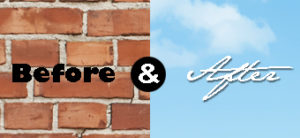When bad ideas are close to brilliant.
All brainstorming sessions yield “bad” ideas. And when you go for lots and lots of ideas, as a productive brainstorming session should, you will have lots and lots of “bad” ideas (or “fertilizer” as I like to think of it).
But bad ideas and good ideas, seemingly at extreme points on a continuum, are often more like points on the equator. If you keep following one far enough, you might get to the other point. I mean how many truly great ideas have been met with, “That’s crazy.” Or, “That won’t work.”
So, when brainstorming, the secret is to find these potentially good bad ideas among the riff raff, and push them along the continuum to see if they might actually be good. Sometimes all it takes is a little nudge.
I hear a lot of people who lead brainstorming sessions say, “there’s no such things as a bad idea.” They’re kidding, right? Actually, if a brainstorm session I’m leading doesn’t have a lot of bad ideas, I get worried that people aren’t pushing hard enough for fresh ideas.
Now, to be clear, the term “good” in brainstorming primarily means fresh. It certainly doesn’t mean proven, because proven has already been done and we don’t do brainstorming to find what already exists. On the other hand, “bad” in brainstorming often is just a way of categorizing ideas that are unproven, scary and, yes sometimes truly, stink-the-joint-out bad.
Bad ideas are often considered bad, simply because they don’t make sense according to what exists. On the good/bad continuum, at one extreme are the really fresh ideas that “don’t make sense” and at the other extreme are the really bad ideas that “don’t make sense.”
Really bad ___bad____________________________good__really good
Are you seeing the equator analogy? Well, then you can see how really good and really bad can be really close (I’m guessing somewhere in the southeast Pacific.)
So a great place to look for the hidden good in the bad ideas is to look at the really, really, really bad ones.
 We often do rounds of what I call 180° Thinking™, in the sessions e conduct, where we intentionally look for bad ideas. This can work, tremendously. We have numerous case histories where big successful ideas have been found using this “look for bad ideas” approach. Great airline service ideas. Great salty snack ideas. Even great ideas in the seemingly risk-averse, why-ever-think-bad financial services industry. Of course, with 180° Thinking we find a lot of truly stinkola ideas, too. Hey, outtakes are cheap.
We often do rounds of what I call 180° Thinking™, in the sessions e conduct, where we intentionally look for bad ideas. This can work, tremendously. We have numerous case histories where big successful ideas have been found using this “look for bad ideas” approach. Great airline service ideas. Great salty snack ideas. Even great ideas in the seemingly risk-averse, why-ever-think-bad financial services industry. Of course, with 180° Thinking we find a lot of truly stinkola ideas, too. Hey, outtakes are cheap.
But, frankly, rather than “try” to come up with bad ideas, I feel there is a more fertile place to find good ideas within bad ones in a brainstorming session. And I recommend you do this toward the end of a session, after the best of the good ideas have been distilled to your finalists, or the almost-completely distilled short list.
If you break your brainstorming group into small teams (and if you don’t do this, you should) ask each team to go to their outtakes and find the 6 or 8 worst ideas. Have each team pass off this short list of really bad ideas to another team in the room, then challenge the teams to convert some of their inherited “bad” ideas into good ideas. You’ll be amazed at what happens.
This exercise invariably yields some of the freshest ideas of the session. Why, because when you start with a “bad” idea you’re usually starting in a fresh place. And, you can only make it better. Better than fresh?! You have to try this to see the result. Are all bad ideas redeemable? No, but, again, this “ya got nothin’ to lose” way of thinking usually yields some pretty rich stuff. Of course often you’re going to have to “Break the ruler,” as I wrote about in a recent post, just to appreciate the true brilliance of these resurrected ideas.
As I implied in the title, really bad ideas are not that far away from really good ideas. Kinda like if you head west from the bad side of Miami eventually you’ll get to, well… the good side of Miami. Or you could take the short cut and just drive across town.

